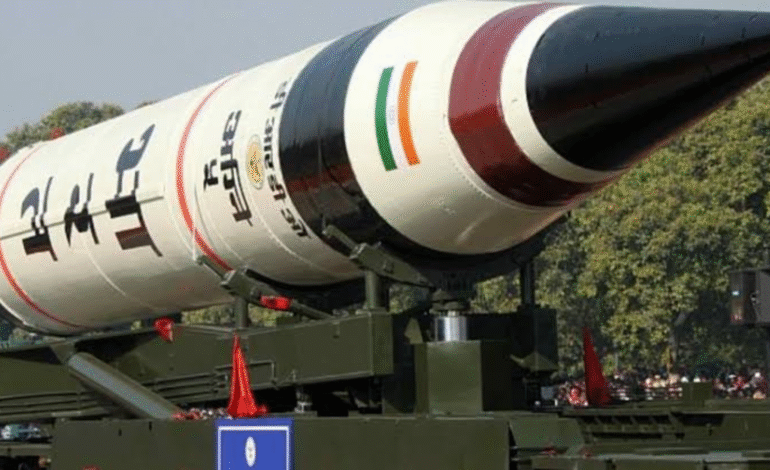India’s Agni‑5 Transforms into Hypersonic Bunker‑Buster

India is upgrading its long-range Agni-5 missile into a highly powerful bunker-busting weapon, capable of destroying underground military targets. This ne
w version, being developed by the Defence Research and Development Organisation (DRDO), will be able to carry a massive 7,500 kg warhead and strike deeply buried enemy infrastructure. The move marks a significant evolution in India’s missile technology, shifting from traditional deterrence to precision attack capabilities.
DRDO Develops New Missile for Underground Strike Missions
The DRDO’s new project focuses on modifying the existing Agni-5 intercontinental ballistic missile (ICBM). The goal is to make it suitable for hitting targets hidden beneath the surface, such as military bunkers, command centers, missile silos, and nuclear weapon storage sites.
According to India Today, the upgraded missile will be equipped with a warhead heavy enough to penetrate 80 to 100 meters below ground. This kind of capability is essential in modern warfare, where adversaries often build critical infrastructure under reinforced layers of concrete and rock to protect them from conventional airstrikes.
This new version is not just a technical modification—it signals a major advancement in India’s missile strategy. While the original Agni-5 was built for long-range nuclear deterrence, the new design focuses on precision attacks and tactical flexibility.
Responding to Global Military Shifts and Technology Trends
India’s move comes shortly after the United States conducted a surprise airstrike on Iranian nuclear facilities on June 22. In that operation, the U.S. used B-2 bombers to drop Massive Ordnance Penetrator (MOP) bombs on underground nuclear sites in Fordow, Isfahan, and Natanz.
However, India is taking a different approach. Instead of relying on aircraft to deliver heavy bombs, India is building a missile-based system that can be launched from the ground. This method provides several advantages—greater speed, faster response time, and flexibility in deployment—especially in regions where airspace dominance might be contested.
Two Versions Designed for Different Strike Scenarios
As reported, India is currently working on two different versions of the upgraded Agni-5 missile. The first is designed for airburst attacks, targeting surface-level military assets and enemy formations. The second version is meant for deep-penetration strikes, aimed at underground bunkers and critical infrastructure.
This dual design reflects a strategic focus on both conventional and specialized warfare. It allows India to deploy a single missile family for multiple missions, improving operational readiness and efficiency.
To accommodate the heavy warhead and structural changes, the missile’s range will be reduced. This trade-off is considered acceptable because the missile is intended for precise, regional targets rather than long-range deterrence.
Hypersonic Speeds for Faster, Harder Strikes
Another major feature of the upgraded missile is its expected hypersonic speed. Reports suggest it could reach speeds between Mach 8 and Mach 20—eight to twenty times the speed of sound.
Hypersonic missiles are extremely difficult to track and intercept. Their high speed gives enemy defense systems very little time to respond, making them highly effective in modern combat. Additionally, the speed creates massive kinetic energy, allowing the missile to penetrate deep into the ground before the warhead detonates.
Shift in Military Doctrine: From Deterrence to Tactical Precision
India’s missile development strategy appears to be evolving. While the Agni-5 was originally designed as a strategic nuclear deterrent, the upgraded version focuses on tactical strike capability. This change aligns with a global trend, where nations are moving from traditional nuclear deterrence to more flexible, targeted military options.
By developing a missile that can strike hidden enemy sites with high precision, India is preparing for future conflict scenarios that involve underground infrastructure and hardened military positions. This move doesn’t suggest aggression but rather a defensive need to stay prepared against evolving threats.
Regional Impact and Strategic Balance
While India has not specified any intended adversary for the upgraded Agni-5, the missile’s capabilities suggest its use would be limited to very specific, high-value targets in the region. These could include enemy military bunkers, missile launch facilities, or underground nuclear operations.
In the broader strategic context, India’s decision mirrors developments in other countries. Nations worldwide are investing in technologies that can counter underground threats. India’s efforts fit within this global pattern and highlight its commitment to keeping its military technologies up to date.
Indigenous Capability and Defence Modernization
The DRDO’s work on the Agni-5 upgrade is part of a larger initiative to strengthen India’s indigenous defense manufacturing. Under the Make in India program, the country has been increasing local production of advanced weapons and military systems.
Developing a highly advanced missile like the Agni-5 bunker-buster domestically highlights India’s growing capabilities in defense R&D. It also reduces dependence on foreign technology and imports, which is vital for maintaining strategic autonomy in sensitive areas like missile systems.
Development Timeline and Future Plans
No official timeline has been released by the DRDO regarding testing or deployment of the upgraded missile. However, experts suggest the prototype design is nearing completion. Once it enters the testing phase, the missile will undergo a series of field trials and safety assessments before being inducted into the armed forces.
These tests will likely include underground impact simulations, warhead detonation checks, and aerodynamic stress analysis at hypersonic speeds. If all goes as planned, the missile could be operational within a few years, depending on funding and technical progress.
Global Context and International Responsibility
Despite the military nature of this development, India has always projected itself as a responsible nuclear power. It is a member of key international export control regimes, including the Missile Technology Control Regime (MTCR), and follows global norms on missile development and usage.
India’s missile programs are designed for defensive purposes, and the country has consistently avoided any aggressive or expansionist policies. The development of bunker-buster capabilities should be viewed within this framework of national security, technological advancement, and strategic self-reliance.
A Smart Upgrade for Modern Strategic Needs
India’s decision to upgrade its Agni-5 missile into a bunker-buster shows how military technology is adapting to the realities of modern warfare. With underground targets becoming more common, nations need advanced tools to neutralize such threats effectively.
The DRDO’s new version of Agni-5 combines heavy warhead capacity, deep penetration ability, and hypersonic speed—all designed to offer a precise and flexible strike capability. While the range may be reduced, the missile’s purpose has shifted from broad deterrence to targeted effectiveness.
This strategic innovation strengthens India’s defense without changing its peaceful intentions. The missile is not a threat—it is a response to a changing world where nations must be prepared, precise, and protective of their security infrastructure.








3 Comments
[…] development not only reflects India’s technological advancement but also strengthens its position in the global space sector. The Gaganyaan mission is expected to […]
[…] India marked a significant milestone in its defence journey with the successful testing of its homegrown Astra Beyond Visual Range Air-to-Air Missile (BVRAAM) equipped with an indigenous Radio Frequency (RF) Seeker. Conducted on a Su-30MKI fighter jet, the test took place off the coast of Odisha and is seen as a vital leap forward in self-reliant defence technology, reinforcing India’s capabilities in the aerospace and missile development domain. […]
[…] in building its own defence systems. On August 20, 2025, the country successfully test-fired the Agni-5 intermediate-range ballistic missile. The launch took place at the Integrated Test Range in Chandipur, Odisha. It was carried out under […]
Comments are closed.